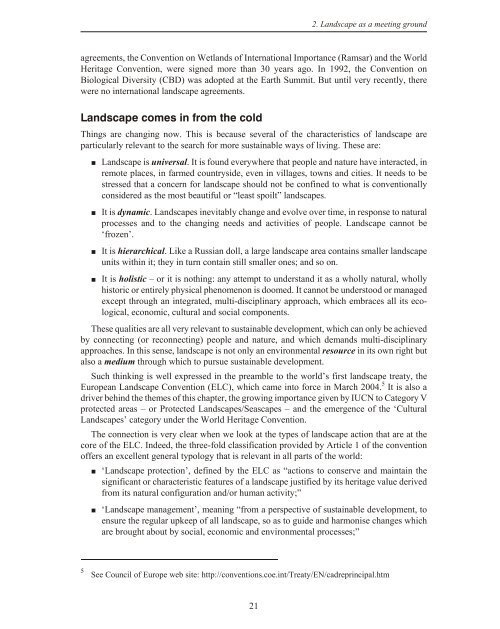The Protected Landscape Approach - Centre for Mediterranean ...
The Protected Landscape Approach - Centre for Mediterranean ...
The Protected Landscape Approach - Centre for Mediterranean ...
Create successful ePaper yourself
Turn your PDF publications into a flip-book with our unique Google optimized e-Paper software.
2. <strong>Landscape</strong> as a meeting ground<br />
agreements, the Convention on Wetlands of International Importance (Ramsar) and the World<br />
Heritage Convention, were signed more than 30 years ago. In 1992, the Convention on<br />
Biological Diversity (CBD) was adopted at the Earth Summit. But until very recently, there<br />
were no international landscape agreements.<br />
<strong>Landscape</strong> comes in from the cold<br />
Things are changing now. This is because several of the characteristics of landscape are<br />
particularly relevant to the search <strong>for</strong> more sustainable ways of living. <strong>The</strong>se are:<br />
<br />
<br />
<br />
<br />
<strong>Landscape</strong> is universal. It is found everywhere that people and nature have interacted, in<br />
remote places, in farmed countryside, even in villages, towns and cities. It needs to be<br />
stressed that a concern <strong>for</strong> landscape should not be confined to what is conventionally<br />
considered as the most beautiful or “least spoilt” landscapes.<br />
It is dynamic. <strong>Landscape</strong>s inevitably change and evolve over time, in response to natural<br />
processes and to the changing needs and activities of people. <strong>Landscape</strong> cannot be<br />
‘frozen’.<br />
It is hierarchical. Like a Russian doll, a large landscape area contains smaller landscape<br />
units within it; they in turn contain still smaller ones; and so on.<br />
It is holistic – or it is nothing: any attempt to understand it as a wholly natural, wholly<br />
historic or entirely physical phenomenon is doomed. It cannot be understood or managed<br />
except through an integrated, multi-disciplinary approach, which embraces all its eco -<br />
logical, economic, cultural and social components.<br />
<strong>The</strong>se qualities are all very relevant to sustainable development, which can only be achieved<br />
by connecting (or reconnecting) people and nature, and which demands multi-disciplinary<br />
approaches. In this sense, landscape is not only an environmental resource in its own right but<br />
also a medium through which to pursue sustainable development.<br />
Such thinking is well expressed in the preamble to the world’s first landscape treaty, the<br />
European <strong>Landscape</strong> Convention (ELC), which came into <strong>for</strong>ce in March 2004. 5 It is also a<br />
driver behind the themes of this chapter, the growing importance given by IUCN to Category V<br />
protected areas – or <strong>Protected</strong> <strong>Landscape</strong>s/Seascapes – and the emergence of the ‘Cultural<br />
<strong>Landscape</strong>s’ category under the World Heritage Convention.<br />
<strong>The</strong> connection is very clear when we look at the types of landscape action that are at the<br />
core of the ELC. Indeed, the three-fold classification provided by Article 1 of the convention<br />
offers an excellent general typology that is relevant in all parts of the world:<br />
<br />
<br />
‘<strong>Landscape</strong> protection’, defined by the ELC as “actions to conserve and maintain the<br />
significant or characteristic features of a landscape justified by its heritage value derived<br />
from its natural configuration and/or human activity;”<br />
‘<strong>Landscape</strong> management’, meaning “from a perspective of sustainable development, to<br />
ensure the regular upkeep of all landscape, so as to guide and harmonise changes which<br />
are brought about by social, economic and environmental processes;”<br />
5<br />
See Council of Europe web site: http://conventions.coe.int/Treaty/EN/cadreprincipal.htm<br />
21

















